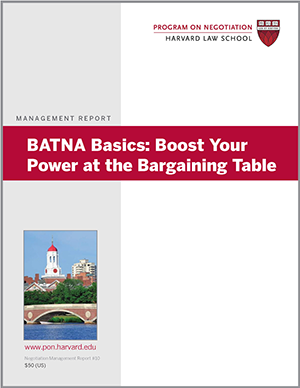
What is BATNA? Negotiations in which each counterpart has a “best alternative to a negotiated agreement” are scenarios in which the incentive to work together must exceed the value of alternatives away from the negotiation table. One negotiation example, labor strikes, highlights common conflict resolution pitfalls.
Impasse at the Negotiation Table: How a BATNA (Best Alternative to a Negotiated Agreement) Informs Negotiation Strategy
The latter half of 2012 saw a slew of labor strikes in the United States. Strikes and lockouts sprung up among groups as diverse as Chicago Public Schools (CPS) teachers, National Hockey League (NHL) players, and National Football League referees, not to mention American Airlines pilots, who staged an unofficial work slowdown as part of their dispute with management.
Why so many management-labor impasses?
The sluggish economy caused many struggling employers to take a firm stance when negotiating salary, pensions, and benefits with labor unions.
And, amid a movement among city and state governments to weaken collective bargaining through new laws and tough negotiations, some labor unions fought back in the form of strikes to keep their power from eroding.
No one likes strikes. They can be financially devastating to employers and employees alike.
And because strikes by their very nature inconvenience the public, whatever popular support striking workers gain may fade when a strike drags on over time.
In an ideal world, management and labor would avoid strikes altogether by listening to each other closely, exploring potential trades across issues, and working collaboratively on proposals.
BATNA and a Collaborative Mindset at the Bargaining Table
What keeps us from this ideal?
Negotiators can tend to view the bargaining process as antagonistic and competitive, creating an atmosphere in which integrative negotiation strategies cannot be explored. As part of this competitive or antagonistic mindset, the pool of resources is understood to be limited and finite. But this is rarely the case.
Understanding a negotiator’s best alternative to a negotiated agreement, or BATNA, a negotiator or her counterpart can generate creative solutions to overcome impasse and arrive at a negotiated agreement.
Knowledge of a counterpart’s BATNA requires a negotiator to understand her counterpart’s interests and motivations on some level. This process in turn may lead the negotiator to think of agreements that more readily satisfy each side’s interests, if not from a collaborative mindset then perhaps one of efficiency.
In addition, a negotiator’s BATNA is a formal knowledge of a negotiator’s walk away options, or those alternatives away from the negotiation table that would fulfill a negotiator’s interests better than an agreement with her counterpart.
Has your BATNA ever helped you negotiate a win-win scenario? Share your experience in the comments.
Adapted from “Negotiators: How You Can Avoid Striking Out,” first published in the December 2012 issue of Negotiation.





Need your work shop in India
Hello,
At this time we do not have any workshops in India.
I feel that dealing with strikes is a little bit more sophisticated thing than just finding out the BATNA of the other side. Understanding the interests behind the positions of the sides is also important, but often such negotiations place workers in a much weaker position. They strike to get at least a bit of power so that the negotiations took place in the first place.
So although a strike is a problem for specific negotiators, it could also a symptom of an unbalanced system that might require a deeper adjustment.